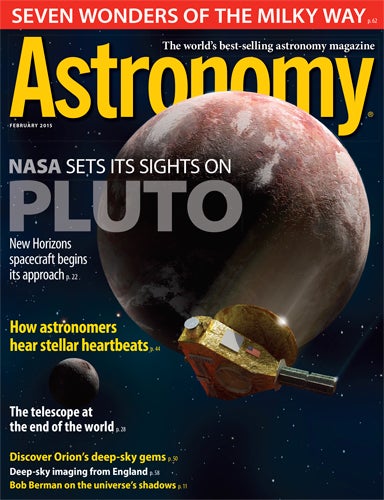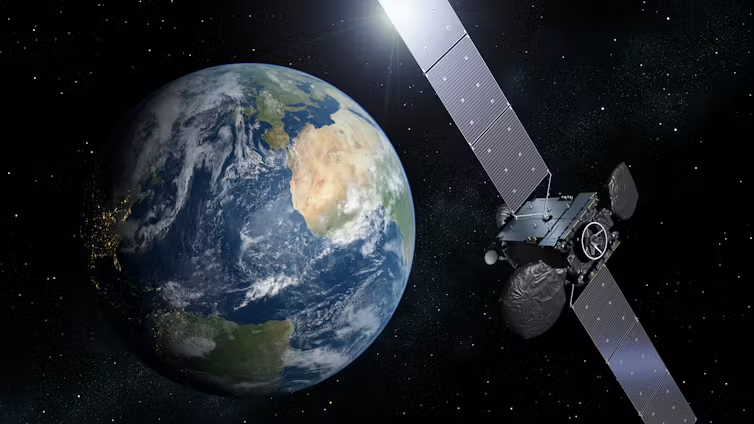In “NASA sets its sights on Pluto,” New Horizons Principal Investigator S. Alan Stern shares a detailed overview of the science instruments currently on their way to Pluto and beyond. He also covers the plan of attack as the spacecraft approaches its target and what kinds of discoveries we hope it will send home. As early as January 15, New Horizons will enter the first phase of its science activities, honing its approach and sending back data. This little spacecraft has been traveling a long time, and it’s about to come alive.
To find out more details about the upcoming Pluto flyby, pick up the February 2015 issue of Astronomy magazine, on newsstands January 6.
“The telescope at the end of the world”
The Big Bang that gave birth to our universe was quite the spectacular event, and it left its imprint across all of space in the form of the cosmic microwave background (CMB). Studying the CMB and its subtle fluctuations can tell scientists about the largest scale structure of the universe and yield insight into the earliest moments of existence. But it takes a powerful instrument in a location with little to no interference to study these tiny signals. Enter the South Pole Telescope. In “The telescope at the end of the word,” Yvette Cendes describes the extreme science taking place in the most remote location on Earth and explains how this telescope and its rival, BICEP2, could be in competition to answer some of the most fundamental questions about our universe.
“How astronomers hear stellar heartbeats”
Some stars hum. Some ring like a bell. And while in space no one can hear their sick beats, the stars can broadcast their concerts via pulsations in the amount of light they give off. Astronomers are eager listeners as these signals can reveal everything from a star’s age to its size to how fast its different layers rotate. In “How astronomers hear stellar heartbeats,” mission scientist Jaymie Matthews explains how space missions from MOST to CoRoT to Kepler can tell us about the hidden insides of stars by listening to the music they play.
“7 wonders of the Milky Way”
You voted, and Senior Editor Michael E. Bakich listened. Here are the “7 wonders of the Milky Way,” as chosen by readers. And since you chose them, we let the readers explain in their own words why each of these objects deserves its place on the list. The Pleiades (M41) and the Orion Nebula (M42) made the cut — what about your favorite object?
February sky events visible without optical aid
- February 6 — Jupiter reaches opposition, dominating the night sky.
- February 20 — Venus and Mars shine next to a waxing crescent Moon.
Also in the February 2015 Astronomy
- “Discover Orion’s deep-sky gems”: Tour a wide range of visually stunning targets scattered throughout Orion, available through binoculars or your favorite small- to medium-sized telescope.
- “A colorful take on northern skies”: Amateur astronomer Gordon Haynes explains his progress as an astroimager from his first 2-inch refractor as a child to his current setup direct from Tele Vue.
- “iOptron’s CEM60 mount tested”: This newly designed, center-balanced equatorial mount has excellent tracking, no backlash, and carries up to a 60-pound (27 kilograms) load.
- “The Sky this Month”: Exclusive star charts will guide you through February’s night sky.
- The February issue also features Snapshot, Breakthrough, Astro News, Ask Astro, Bob Berman’s Strange Universe, Glenn Chaple’s Observing Basics, Stephen James O’Meara’s Secret Sky, Adam Block’s Cosmic Imaging, Astro Sketching, New Products, Letters, Web Talk, Reader Gallery, and Final Frontier.
Astronomy offers you the most exciting, visually stunning, thorough, and timely coverage of the heavens above. Each monthly issue includes expert science reporting, vivid color photography, complete sky-event coverage, spot-on observing tips, informative equipment reviews, and more. All of this comes in an easy-to-understand user-friendly style that’s perfect for astronomers at any level. Contact Astronomy, the world’s best-selling astronomy magazine, at 262.796.8776 or email editor@astronomy.com.










